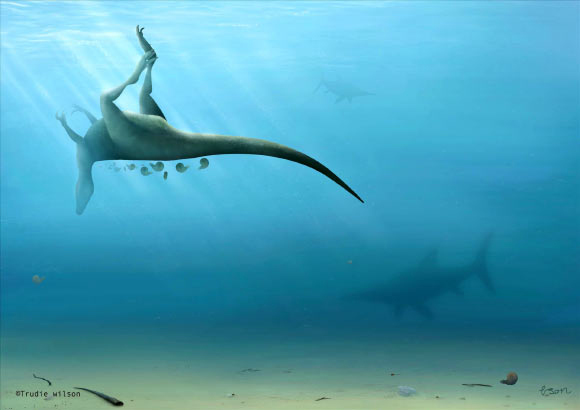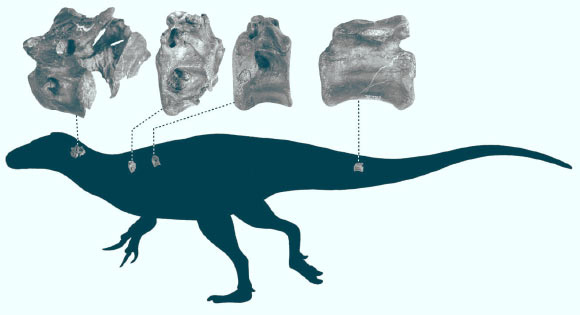Vectaerovenator inopinatus – “Unexpected Air Filled Hunter”
Vectaerovenator inopinatus – “Unexpected Air Filled Hunter from the Isle of Wight”
This week has seen the announcement of the discovery of four fossil bones from the foreshore near Knock Cliff, south of the town of Shanklin on the Isle of Wight that led to the naming of a new species of carnivorous dinosaur. The new theropod has been named Vectaerovenator inopinatus (pronounced: Vec-tare-row-ve-nay-tor in-op-pin-ar-tus). Most of the media outlets that have covered this story have focused on the dedicated people who found the fossils and the research team responsible for describing them. The fossils were found over a period of several weeks in 2019 in three separate discoveries, two by individuals and one by a family group, who all handed in their finds to the nearby Dinosaur Isle Museum (Sandown).
The Carcass of Vectaerovenator inopinatus Floats Out to Sea

Picture credit: Trudie Wilson
A Vital Contribution to the Earth Sciences
The contribution from amateur fossil hunters cannot be underestimated, such enthusiastic and knowledgeable fossil hunters continue to make a hugely significant contribution to the Earth sciences. The fossil material, consisting of four vertebrae (one cervical, two dorsal and one caudal), are, with the exception of some isolated teeth, the youngest non-avian theropod remains reported from Mesozoic strata from the British Isles.
The fossils come from the Aptian (Early Cretaceous), Ferruginous Sandstone Formation of the Lower Greensand Group and as these are marine deposits, it is likely that the carcass was washed out to sea and floated for some time before eventually settling on the seabed. Most Early Cretaceous dinosaur fossil material known from the British Isles come from the Wealden Group or the older Purbeck Limestone Group.
Exposures of the generally younger Ferruginous Sandstone Formation can be found in Dorset as well as the southern part of the Isle of Wight. These sediments were laid down during a period of rising sea levels. The rising seas engulfed the lower lying coastal swamps, floodplains and deltas that had been home to many different types of dinosaur. Dinosaur fossils are exceptionally rare in these strata. For example, a single, isolated theropod tooth found at Punfield Cove, Dorset represents the very first record of a dinosaur from the Lower Greensand of Dorset.
As the four fossil bones ascribed to V. inopinatus are consistent in size and have the same adhering matrix, it is very likely the all four bones came from a single, individual dinosaur.
Silhouette of Vectaerovenator inopinatus with the Fossil Bones in Approximate Life Position

Picture credit: Darren Naish
Vectaerovenator inopinatus – One of the Few Valid British Greensand Taxa
What fossils that are associated with the Lower Greensand Group, are often highly fragmentary, substantially eroded and often the result of re-deposition from older strata. The four vertebrae represent the youngest non-avian theropod remains reported from the British Mesozoic. Described as a mid-sized tetanuran, the Vectaerovenator specimen is estimated to represent a four-metre-long animal, one that roamed Europe approximately 115 million years ago. It is the first diagnosable theropod taxon to be named from Aptian deposits associated with Europe.
“Unexpected Air-filled Hunter from the Isle of Wight”
The scientific name translates as unexpected, air-filled hunter from the Isle of Wight. The neck and back bones are chambered (camerate) and full of air pockets (highly pneumatic). These are adaptations to help lighten the skeleton and extensions to the lungs, part of an extremely efficient respiratory system seen today in living birds.
The shape of the cervical vertebra, along with the evidence of highly pneumatised bones indicate that Vectaerovenator was a member of the Tetanurae, a clade of theropod dinosaurs defined as all theropods more closely related to birds than they are to the genus Ceratosaurus. As such, this is by far the largest clade of theropods known, it includes the tyrannosaurs, Maniraptora, megalosaurs, allosaurs, ornithomimosaurs and the Aves. It is not possible to classify these bones any further, down to the family or the genus name for example.
Formal Scientific Paper Expected Soon
The formal scientific paper is expected to be published next month in the journal Papers in Palaeontology.
The continuing transgression of the sea led to much of the land in this region becoming fully submerged. Deposition from deltas stopped, land-derived sediments to this part of the world ceased and for millions of years the only material to accumulate on the seabed were the microscopic remains of eukaryotic phytoplankton (coccolithophoroids). Many coccolithophorids are covered in overlapping scales made of calcium carbonate. Their remains formed the beautiful white cliffs, (which gave the Isle of Wight its name) and formed the stunning white cliffs associated with the coast of south-eastern England and elsewhere in Europe.
Everything Dinosaur acknowledges the assistance of a media release from the University of Southampton in the compilation of this article.
Visit the Everything Dinosaur website: The Everything Dinosaur Website.

